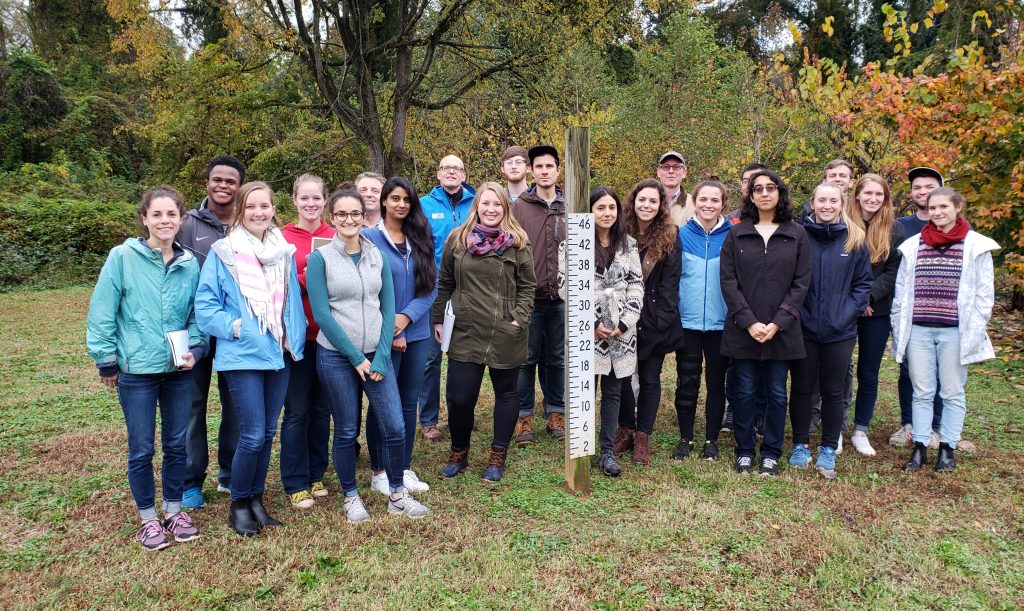
Shortly after Hurricane Florence came through North Carolina, causing record rainfall and floods, students at the University of North Carolina at Chapel Hill visited a county where years of investments in flood control measures have yielded clear results.
The students on the field trip were enrolled in the “Planning for Natural Hazards and Climate Change Adaptation” class taught by Dr. Gavin Smith, a CRC researcher at North Carolina State University. The students traveled to Charlotte, N.C., on Nov. 9, 2018, to learn about the combined city-county government’s efforts at proactive property buyouts in frequently flooded areas. The Charlotte-Mecklenburg government this year celebrated the 25th anniversary of its buyout program.
Many of the students on the field trip are participants in the Natural Hazards Resilience Certificate Program led by Dr. Smith. The class is one of the courses required for students to earn the 10-hour certificate, which is funded through Dr. Smith’s CRC education project and offered in partnership with DCRP. The program is open to students from UNC, North Carolina State University and Duke University, and is composed of three required classes and one elective. The required classes include “Planning for Natural Hazards and Climate Change Adaptation” and “Survey of Natural Hazards and Disasters” course. Students also attend the one credit-hour “Natural Hazards Resilience Speaker Series” held each spring semester.
Dr. Smith has recently moved to North Carolina State University (NCSU), where he is a professor in the Department of Landscape Architecture. He is in the process of developing a graduate certificate in Disaster Resilient Policy and Design at NCSU and helping to coordinate the creation of a university-wide focus on disaster resilience.
While visiting Charlotte, students heard presentations on the city-county’s efforts from Mecklenburg County’s Storm Water Services team, including Mecklenburg County Water & Land Resources Director Dave Canaan and Storm Water Engineering & Flood Mitigation Program Manager Tim Trautman.

After learning about the program, students toured several sites that were the focus of the buyout program since the early 2000s.
Charlotte-Mecklenburg was among the first municipalities in North Carolina to develop a comprehensive stormwater utility in 1993, according to Trautman. It began issuing formal guidance on managing stormwater runoff in 1998; previously stormwater was the responsibility of property owners. A fee structure was put in place based on the amount of impervious surface on a property, Trautman said. The program is so successful that just 10 properties reported flood damage during Hurricane Florence, a storm that set rainfall and flooding records across North Carolina. The county estimates that the buyout program saved the county more than $2 million in damages.
Unlike many cities of similar size – including Louisville and Nashville – Charlotte is not centered on a major river. However, flooding was widespread in several parts of the county after major rains, and after two 1-percent (or “100-year”) floods in the 1990s, the county reconsidered its service model. Properties outside the formal floodplain were flooding, Trautman said, so the county worked to build a coalition with businesses and developers to institute a formal buyout program. Developers don’t like to build homes and businesses that will flood, Trautman said.

Buying out flooded properties is typically done by state governments, often with federal disaster funding, but Charlotte-Mecklenburg localized the process in 1999 by returning parts of neighborhoods to their natural state or incorporating them into existing greenways and parks. Trautman said the county is “buying down risk” to help with water quality, increase recreation opportunities for residents and reduce the need to spend on flood repairs. The county verifies that mitigation actions are a good investment with data collected over time.
“Our motto is ‘let floodplains flood and get people out of harm’s way,’” Canaan said.
Additional steps included installing flood detectors in creek beds in 2003, digitizing flood maps in 2010 and initiating a retrofit program – through which the county largely subsidizes home and business repairs to increase flood resilience – in 2015.

“The precision, coordination, and thoughtfulness of the Charlotte stormwater mitigation program was really striking,” Emily Paul, a first-year UNC graduate student who is part of the certificate courses, said. “They based their decisions on carefully-gathered data and research, aiming to fairly set about the buyout process, while integrating input from the community.”
“I am especially interested in how cities facilitate stormwater management and flood risk to promote the health, safety, and well-being of residents. We already understand the social determinants of health as related to other contexts; at the juncture of these fields, I’m interested in the way that housing, infrastructure, and land use can be utilized to benefit public health and mitigate the effects of climate change.”
Certificate course includes speakers
As part of the certificate courses, Dr. Smith hosts a series of speakers in his class and in additional public talks during the spring semester that focused on a variety of topics related to natural hazards.
Learn more at https://planning.unc.edu/academics/certificates.
